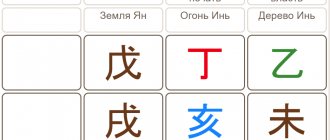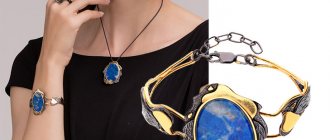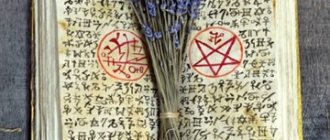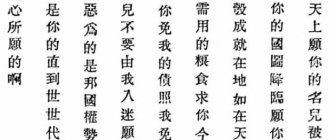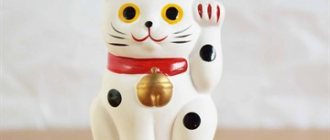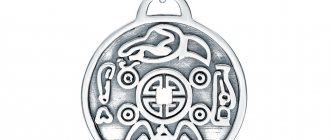From this article you will learn:
- What symbols represent Buddha in Buddhism?
- What are the 8 good symbols in Buddhism and what do they mean?
- What 8 Precious Objects did Buddha Receive?
- What symbolic objects are used to offer to Buddha?
Buddhism has its roots in the 4th–6th centuries. BC e. - the period when Siddhartha Gautama began to popularize his own religion in India about trials, the achievement of Nirvana and spiritual rebirth. Siddhartha did not welcome the use of his image, and in order to illustrate his teachings, he used various signs. There are special symbols of this religion that Buddha received as a gift from God after his enlightenment. We will tell you what each important symbol of Buddhism means in this article.
The history of the appearance of Buddhist symbols
There is a beautiful legend about how eight auspicious symbols appeared in our world.
According to this legend, on the day Buddha attained enlightenment and higher wisdom under the sacred tree, many gods came to pay their respects and presented him with gifts - eight auspicious symbols.
Brahma presented the deity to the Enlightened One with the Dharmachakra (Wheel of Learning). The heavenly god Sakra gave the White Shell to spread the wisdom of the Buddha to each end of the Universe. The earthly god Stavara handed the Buddha a Precious Vessel full of the drink of eternal life. The remaining gods presented Buddha with a pair of Golden Carps, a Lotus, a Victory Banner and a Good Umbrella.
All these symbols in Buddhism became sacred, demonstrating the close connection of the divine with the human world.
We have selected interesting articles for you:
Yin and Yang: meaning, translation, hidden meaning, history of appearance
19.12.2021
What is the secret of God's many-armed nature?
21.12.2021
Symbolism of Buddhism and images of Buddha
Siddhartha Gautama opposed his followers and admirers to worship him. Therefore, both his own images and the images of his teachings do not belong to the period of his life. However, Gautama expressed his thoughts metaphorically in his sermons and used certain images, for example, when he talked with his students on the topic of turning the wheel of Dharma.
The main symbols of Buddhism and their meaning became known after the death of Gautama. For the most part, these were images reflecting his philosophy of life. The earliest sacred signs of Buddhism are the stupa and the wheel of Dharma.
As the religion spread and divided into different teachings, the symbols of Buddhism became more and more numerous. This religion gradually borrowed elements from the cultures with which it came into contact.
To depict the Enlightened One in different periods, the following symbols of Buddhism were mostly used:
- Wheel with 8 spokes, or Dharmachakra. Symbolizes the turning of the Enlightened Wheel of Truth and the change of fate.
- Bodhi. This tree is a symbol of Buddhism. It is believed that Gautama became Enlightened while sitting under him.
- Buddha's footprints. According to legend, he left footprints on the stone to remind his descendants of his presence in their material world.
- Empty Throne. Reminiscent of Gautama's royal origins and carries the idea of spiritual dominion.
- Begging bowl. A sign of Buddha's renunciation of all material goods. The bowl also symbolizes the lifestyle of a monk.
- A lion. One of the strongest symbols. According to tradition, the lion represents the rights of the ruler, strength and power.
Much later, the “Eyes of Buddha” symbol appeared, which can now often be found in Nepal. The Enlightened One looks in all four directions, which means his all-seeing mind.
Victory Banner
The victory banner was presented to Buddha by the god Krishna as an ornament for his body. This cylindrical multi-tiered figure symbolizes the victory of the Buddha's teachings over ignorance and death.
The banner means victory over the enemy and obstacles, personifies victory over demons, mara and adherents of false views. A symbol of the victory of the Buddha's teachings over death, ignorance, as well as over everything harmful and destructive in this world.
The Sanskrit word dhwaja means banner, flag or emblem, and was originally a battle flag in the ancient Indian art of war. This banner adorned the back of the great warrior's chariot and was mounted behind the great or royal umbrella. Each flag bore a specific emblem of a king or warrior. Krishna's chariot, for example, was decorated with a garuda flag, and Arjuna's with a monkey flag. But most often the dhwaja was the emblem of Shiva, the great god of death and destruction, whose banner was decorated with a trident. This trident symbolized the victory of Shiva over the three worlds or “three cities” located on the earth, above the earth and below it. In the Indian art of war, the army banner often took on terrifying forms to instill fear in the enemy. This could be, for example, the head impaled on a stake and the skin of an enemy or victim flayed off. The heads and skins of ferocious animals were often used, particularly the tiger, crocodile, wolf and bull. Also on the banner were large images of other fearsome creatures such as a scorpion, a snake, a vulture, a raven and a garuda.
The crocodile-headed banner or so-called makaradhvaja was the emblem of Kamadeva, the Vedic god of love and desire. As a "tempter" or "deceiver", Kamadeva can be considered the Hindu equivalent of Mara, the "evil incarnate" who tried to prevent the Buddha from achieving enlightenment.
In early Buddhism, the image of Mara as a demonic creator of obstacles to spiritual progress was represented by a group of four maras or "evil influences". The idea of these four maras was originally based on the four divisions of the army of Mara: infantry, cavalry, elephants and chariots. The first of these four maras is the demon of the five accumulations of personality (skandha mara). The second is the demon of interfering emotions (klesha mara). The third is the demon of death (mrityu mara). And the fourth Mara - “son of god” (devaputra mara) - the demon of desire and temptation. It is this fourth Mara that corresponds to Kamadeva, “the king of the gods of the highest level of the desire world.” The Buddha is believed to have transcended the veils of Kamadeva's sensual desires in the twilight before Enlightenment by meditating on the "four limitless qualities": compassion, love, sharing joy and equanimity. At dawn he overcame the Mara of accumulation and the Mara of interfering emotions. But only three months before the end of his life he managed to defeat the mara of death through the power of his fearless determination to enter the final nirvana (parinirvana). Early Buddhists adopted the crocodile-headed Kamadeva symbol as a symbol of the Buddha's victory over the four maras. Usually four such banners were installed in the main directions around the stupa of Enlightenment. In a similar way, the gods decided to plant a victory flag on the top of Mount Meru to glorify Buddha as the “victor” who defeated the armies of Mara.
This "banner of victory in ten directions" has a frame of precious stone, a crown with a moon and a sun, and a hanging triple flag of three multi-colored silks, decorated with "three victorious harmonious beings." In the Tibetan tradition, eleven variations of the victory banner correspond to eleven specific methods for transcending veils. Many variants of the banner are found on the roofs of temples and monasteries: four flags are usually placed at the corners of the roof, symbolizing the victory of the Buddha over the four maras.
The most traditional type of banner is a cylindrical banner on a long wooden pole. The top of the banner follows the shape of a small white umbrella, and on top of it is a wish-granting jewel. This domed umbrella is edged with an ornate golden cross with makara tails at the ends from which hang waves of yellow or white silk scarf. The cylindrical base of the banner is draped with several vertical layers of multi-colored silk folds and pendants of precious stones. The base is decorated with a wavy silk apron with flowing ribbons. The upper part is decorated with a tiger skin rim, symbolizing the victory of Buddha over anger and aggression. Many aspects hold the banner of victory, particularly those related to wealth and power. For example, Vaishravana, the great King and protector of the North.
Goldfish
They are called so because of the shine emanating from their scales, similar to the shine of gold. Usually, fish is a decoration and a sign of the well-being of rivers and lakes. So these fish represent full-fledged wealth. A symbol of deliverance from suffering and achievement of spiritual liberation. Just as a fish swims in water without knowing any barriers, so a person who has achieved enlightenment knows no boundaries or obstacles.
In Sanskrit, two fish are known as "matsyaungma", which means "pair of fish". This indicates their origin from the symbol of the two sacred rivers of India - the Ganga and the Yamuna. Metaphorically, these rivers represent the solar and lunar channels, or psychic nerves (nadis), which arise from the nostrils and carry the intermittent rhythms of breath, or prana.
In Buddhism, golden fish represent happiness because they have complete freedom of movement in the water, and also fertility because they can reproduce very quickly.
Fish often swim in pairs, and in China a pair of fish symbolizes marital unity and fidelity. The two golden fish, female and male, are usually depicted symmetrically and in the shape of a carp with graceful tails, fins and gills, and long antennae starting from the upper jaw. Carps are traditionally considered the holy fish of the east due to their elegant beauty, size and longevity, as well as their association with certain benevolent deities. Golden fish are an attribute of the Indian Mahasiddha Tilopa, and symbolize his realization as well as his ability to liberate people from the ocean of cyclical existence - Samsara. According to one version, a pair of golden fish was given to Buddha by the god Vishnu as an ornament for his eyes. Symbolizes freedom from the fear of drowning in the ocean of suffering and spiritual liberation.
White shell, with a scroll turned to the right
The white shell, twisted clockwise, was presented to the Buddha by the god Indra as an ornament for his ears. Symbolizes the sound of the Buddha's Teachings spreading freely everywhere and awakening disciples from the sleep of ignorance.
This shell is very rare. It is believed that a mollusk acquires it after five continuous births as an ordinary mollusk. The sound of the conch shell represents the euphonious voice of Dharma. A symbol of spreading the Buddha's teachings and awakening from the sleep of ignorance. Just as the sound of a conch shell flies unhindered in all directions, so the teachings of the Buddha spread everywhere, awakening sentient beings from the sleep of ignorance.
The white shell, whose spiral turns clockwise, is a famous Indian attribute of the heroic gods, whose mighty shells proclaimed their courage and victories in war. The fire-spewing conch shell of Vishnu was called Panchajanya, which means “having control over the five types of beings.” Arjuna's conch was known as Devadatta, which means "given by God" and its triumphant voice would strike terror into the enemy. The shell is akin to the modern horn as a war trumpet, as an emblem of strength, power and dominance. It is believed that her auspicious voice drives out evil spirits, wards off natural disasters and scares away harmful creatures.
Vishnu's fire conch (Panchajanya) is in his upper left hand and corresponds to the wheel or chakra in his upper right hand. The first five of the ten avatars of Vishnu hold these two attributes in their hands. In the Hindu tradition, Buddha is considered the ninth of the ten rebirths of Vishnu. When the great gods of the heavens Indra and Brahma are usually depicted in front of the Buddha's throne, they are usually holding the attributes of Vishnu - a conch shell and a wheel - which is probably not a mere coincidence. Vishnu is also commonly known as the "great man" (Skt. mahapurusha) or the "right-hand god" (Skt. dakshinadeva). The same can be applied to the Buddha with his hair curling to the right and his body marked with thirty-two signs of auspicious birth (Skt. mahapurusha-lakshana). Early Hindus classified shells by gender, with the thicker convex shells considered male or purusha and the thinner, graceful shells female or shankhini.
The Hindu division into four castes also corresponded to the shape of the shells: smooth white shells corresponded to the Brahmin priestly caste, red to the Kshatriya warrior caste, yellow to the Vaishya merchants, and dull gray to the simple laborer - Shudra. There was another division - according to the type of spiral. Common shells that curled to the left were called vamavarta, while the rarer shells that curled to the right were called dakshinavarta and were considered most suitable for use in rituals. The top of the shell is sawed off to form a horn and the wind swirling in a right-handed spiral to create sound symbolizes the true (“right-hand”) proclamation of the Dharma. Brahmanism adopted the heroic conch as a ritual symbol of religious supremacy. Early Buddhists similarly adopted this symbol as an emblem of the superiority of the Buddha's teachings. Here the conch shell symbolizes fearlessness in proclaiming the truth of the Dharma and his call to awaken and work for the benefit of others. One of the thirty-two symbols of the Buddha's body is his deep and sonorous voice, reminiscent of the voice of a conch shell, which spreads to all ten directions of space. In iconography, this feature is depicted by three shell-shaped curved lines on his throat.
As one of the eight auspicious symbols, the shell is usually turned vertically, often with a ribbon running across its bottom edge. The right direction of the spiral is indicated by the bend and the entrance hole pointing to the right. The sink can also be turned horizontally, in which case there will be aromatic liquids or oils inside. As an attribute that is held in the hand and symbolizes the proclamation of the Buddha's teachings, as one of the aspects of speech, it is usually found in the left hand - the hand of “wisdom”.
Offerings
Making offerings is a common practice in the East. In Tibet they are symbolized by small bowls filled with water, flowers, incense, candles, incense and food. This is due to the ancient tradition of receiving dear guests. The gifts are as follows:
- Water to cleanse your mouth or face. This means all favorable causes and conditions that bring positive effects.
- Water for washing feet. It is mixed with incense or sandalwood oil. The symbolic meaning is purification, getting rid of negative karma and obscurity.
- Flowers. The personification of generosity and an open heart.
- Incense symbolizes discipline and focus. They are an intermediary in communication between a person and the Buddha. Also means perseverance or joyful effort. Thanks to this quality, a person approaches enlightenment.
- Light is a symbol of stability and clarity, beauty that dispels ignorance.
- Food that has many different tastes means samadhi, nectar or ambrosia, which will “feed” the mind.
- Musical instruments. Their nature is wisdom, beneficial to the ears of Buddhas, Bodhisattvas and all enlightened beings. All phenomena have a nature of interdependence, causes and conditions, but sound is especially easy to understand.
Lotus
A white lotus flower with a thousand petals was given to Buddha by the god Kama as an ornament for his tongue. Symbolizes the purity of teaching and purification of body, speech and mind, leading to Enlightenment.
Like a lotus flower, born unsullied from mud, so here it personifies non-attachment to samsara, although it resides in it. In Buddhism, it is a traditional symbol of purity. The lotus is born in muddy swamp water, but emerges unsullied and pure.
Likewise, beings born in one of the worlds of samsara, but who sincerely practice the noble teachings of the Buddha, are able to get rid of delusions over time. It represents the flowering of noble qualities that manifest themselves completely independently of the imperfections of cyclical existence. The lotus on which the buddha aspects sit or stand represents their sacred origin. They are spontaneously manifested, innately perfect and absolutely pure in body, speech and mind. These aspects appear in cyclical existence, but are completely uncontaminated by its shortcomings, emotional obstacles and mental veils. The lotus is the emblem of Amitaba, the red Buddha of the west and “the head of the lotus family or padma family.”
The qualities of Amitaba are associated with the redness of fire, vital fluids, evening twilight, the summer season and the transformation of passion into discriminating wisdom. Amitaba's wife is Pandara and the red lotus is her attribute. The main bodhisattva of Amitaba is Padmapani Avalokiteshvara - “Holder of the Lotus” - the bodhisattva of great compassion. A lotus in Buddhism usually has four, eight, sixteen, twenty-four, thirty-two, sixty-four, one hundred or one thousand petals. These numbers symbolically correspond to the inner lotuses or chakras of the subtle body, as well as to the number of components of the mandala. As an attribute held in the hand, the lotus is usually pink or light red with eight or sixteen petals.
Lotus flowers can also be white, yellow, gold, blue and black. White Tara, for example, holds a sixteen-petalled white lotus utpala in her hands. The yellow or golden lotus is commonly known as padma, while the more common red or pink lotus is called kamala. The Sanskrit term utpala specifically refers to blue or black "night lotus", but its Tibetan equivalent under the same name can refer to any color lotus.
Blagoy Umbrella
This symbol personifies the protection of the mind from the sultry heat of obscurations, and also protects against suffering. A symbol of good deeds performed to protect living beings from diseases, harmful forces, obstacles, as well as the suffering of the three lower and three higher worlds. Just as an ordinary umbrella protects from rain and heat, so a precious umbrella provides protection from the adversities and misfortunes of samsara.
The umbrella is a traditional symbol of noble birth and protection. Its shadow protects from the scorching sun, its coolness symbolizes protection from the painful heat of suffering, desire, obstacles, diseases and harmful forces. As a symbol of noble birth and special wealth, an umbrella indicates position in society: the more umbrellas carried by those around you, the higher the status. Traditionally, thirteen umbrellas corresponded to the status of a king, and early Buddhism in India adopted this number as a symbol of the Buddha's supreme position as the "universal monarch", or Chakravartin. Thirteen umbrella-shaped wheels connect to form conical stupa spiers that mark major events in the life of the Buddha or contain his relics.
An umbrella over one's head naturally signifies glory and respect, which led to its emergence as a significant symbol in early Buddhist art. The precious white umbrella was once presented to the Buddha by the lord of the gods, Mahadeva, as a head decoration. Symbolizes protection from disease, evil spirits and suffering in this and future lives. On a spiritual level, it dispels anger, passion, pride, envy and stupidity.
According to another version, it is believed that the Naga king presented the Buddha with an umbrella decorated with precious stones. The umbrella was made of gold, and the stones along its edges exuded nectar. Melodious bells hung from it, and the handle was made of sapphire. In the images there is often a large white umbrella of fine workmanship above the head of the Buddha, and this large white umbrella later evolved into the Vajrayana goddess Dukar. “White Umbrella” is one of the most complex yidams of the Vajrayana - thousand-armed, thousand-legged, thousand-headed and looking with “thousands of millions” of eyes. Her two-armed form is often depicted holding a white umbrella over a seated Buddha. A typical umbrella in Buddhism consists of a long white or red sandalwood handle or shaft, topped with a small golden lotus, a vase and a jeweled tip. Its dome-like frame is covered with white or yellow silk and folds of silk fringe edge the edges along with multi-colored silk pendants and frills. Sometimes the umbrella is also decorated with peacock feathers, hanging necklaces made of precious stones and pendants made of yak tails.
The ceremonial silk umbrella is usually just under one and a half meters in diameter, allowing it to be held at least a meter above the head. Square or octagonal umbrellas are also common, and large yellow or red umbrellas are often hung above the throne of the chief lama, as well as above the image of the central yidam in monasteries and temples. A white or yellow silk umbrella is a symbol of spiritual dominion, while a peacock feather umbrella more often represents temporal power. The umbrella's dome symbolizes wisdom, and its hanging silk frills represent various methods of compassion or skillful means. The white umbrella that was offered to the Buddha most symbolizes his ability to protect all beings from delusions and fears.
Endless knot
Just as this knot has no end, so this symbol personifies the complete acquisition of the Immeasurable Virtues and the Five Types of Primordial Wisdom. A symbol of the interdependence of all phenomena and living beings in the Universe. The Sanskrit term "srivatsa" means "beloved Sri". Shri is the goddess Lakshmi, the consort of Vishnu, and srivatsa is an auspicious sign that adorns the chest of Vishnu. The distinctive feature of Lakshmi on Vishnu's chest corresponds to the fidelity of his heart to his wife, and since Lakshmi is the goddess of wealth and auspicious fortune, the srivatsa naturally becomes an auspicious symbol. This is usually either a triangular curl or an upturned diamond that closes at four opposite corners. Krishna, the eighth reincarnation of Vishnu, also has srivatsu in the center of his chest. This curl of hair has another name - nandyavarta - which means "curl of happiness", in which case its shape resembles a swastika or the Greek hooked cross (gammadion).
In Indian and Chinese depictions, the Buddha often has a swastika in the center of his chest, which symbolizes his enlightened mind. Another likely variation of the swastika and endless knot comes from the S-shaped markings on the cobra's hood. This in turn gave birth to the Nagayantra, where two or more intertwined snakes form an endless knot or yantra. In its final development into the Buddhist geometric symbol of the eternal knot or "luck diagram" which "revolves like a swastika", this symbol can be related to the srivatsa swastika, as both symbols were used in early Indian traditions.
As a symbol of Buddha, the endless knot represents his infinite wisdom and compassion. As a symbol of the Buddha's teachings, it represents the continuity of the twelve links of dependent origination that underlie cyclical existence.
In one of the descriptions you can find the following words: the endless knot was given to Buddha by the god Ganesha as an ornament for his heart. Symbolizes the changing nature of time, the impermanence and interconnection of all things, as well as the unity of compassion and wisdom.
Precious Vase
The precious vessel that fulfills all wishes was presented to the Buddha by the god Shadana as an ornament for his throat. Symbolizes the fulfillment of all desires, both temporary (gaining longevity, wealth and merit), and the highest - gaining liberation and Enlightenment. The storehouse of all realizations, which is the basis of priceless virtues and pure virtues.
Symbol of long life, wealth and prosperity. The Vase of Jewels is mainly a symbol of some yids of wealth such as Dzambhala, Vaisravana and Vasudhara, it is their attribute and is usually placed at their feet. One form of the goddess of wealth Vasudhara stands on a pair of horizontal jewel vases from which flow an endless stream of precious stones.
As a sacred "vase of abundance" (Tib. bumpa zangpo), it has the property of spontaneous manifestation: no matter how many jewels are taken from the vase, it remains invariably full. A typical Tibetan jewel vase is depicted as an ornate golden vase with a lotus petal motif encircling its various parts. A single wish-granting jewel or a group of three jewels crowns its top edge as a symbol of the Buddha, Dharma and Sangha. The great vase of jewels, as described in the Mandala offering, is made of gold and adorned with numerous precious stones.
A silk scarf from the world of the gods is tied around its neck, and the top is sealed with a wish-granting tree. The roots of this tree exude concentrated water of longevity, miraculously creating all kinds of wealth. Sealed vases of jewelry can be placed or buried in sacred places of the earth, such as mountain passes, pilgrimage sites, springs, rivers and oceans. In this case, their function is to spread abundance and pacify the spirits living there.
